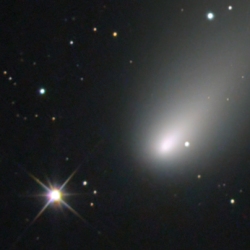
Comet Schwassmann-Wachmann by Andrea Tamanti
Arnold Schwassmann and Arno Arthur Wachmann were two German astronomers credited with the discovery of three comets during the first third of the last century. Near the middle of this month, their third discovery will pass by Earth, twenty five times more distant than the Moon, on its latest five and a third year orbit from near the Sun to the distance of Jupiter.
Its small nucleus is approximately two tenths of a mile across – a size that is generally incapable of producing a spectacular show as it swings by Earth. Yet, two orbits ago, in 1995, the comet did something unexpected – it brightened considerably as it was observed breaking apart. This year, this comet will pass closer to Earth than any in the past twenty-five years. But this is no typical cometary flyby – Comet Schwassmann-Wachmann 3 has become a swarm of small comets!
During the 1995 passage, the nucleus of this comet split apart into three objects traveling single file but when it passed Earth during the fall of 2000, four separate nuclei were observed. Images captured in late March of this year revealed eight individual pieces and by April 10, scientists could see nineteen fragments and many of these were spawning even smaller pieces. Each piece is a mini-comet with its own star-like nucleus and tail.
Closest approach to the Sun will occur on June 7. But on May 8, a few days before their closest approach to Earth, the pieces of Comet Schwassmann-Wachmann will pass very close to the Ring Nebula in the constellation Lyra. Some fragments may even appear to pass over this famous night sky landmark. For folks living near Paris, this will occur around 5AM in the morning and for those who live on the southeast coast of the United States, a good view of this event will be happen about 11PM on May 7.
This excellent close up picture is of the comet’s “C” fragment- one of the three first seen in 1995. It was taken by Andrea Tamanti on April 24, 2006 at about 2AM local time from his home about 20 miles outside Rome, Italy. Andrea used a ten-inch Schmidt-Cassegrain telescope and a 1.3 mega pixel astronomical camera. Four separate exposures totaling 36 minutes were required to produce this full color image.
Do you have photos you’d like to share? Post them to the Universe Today astrophotography forum or email them, and we might feature one in Universe Today.
Written by R. Jay GaBany
